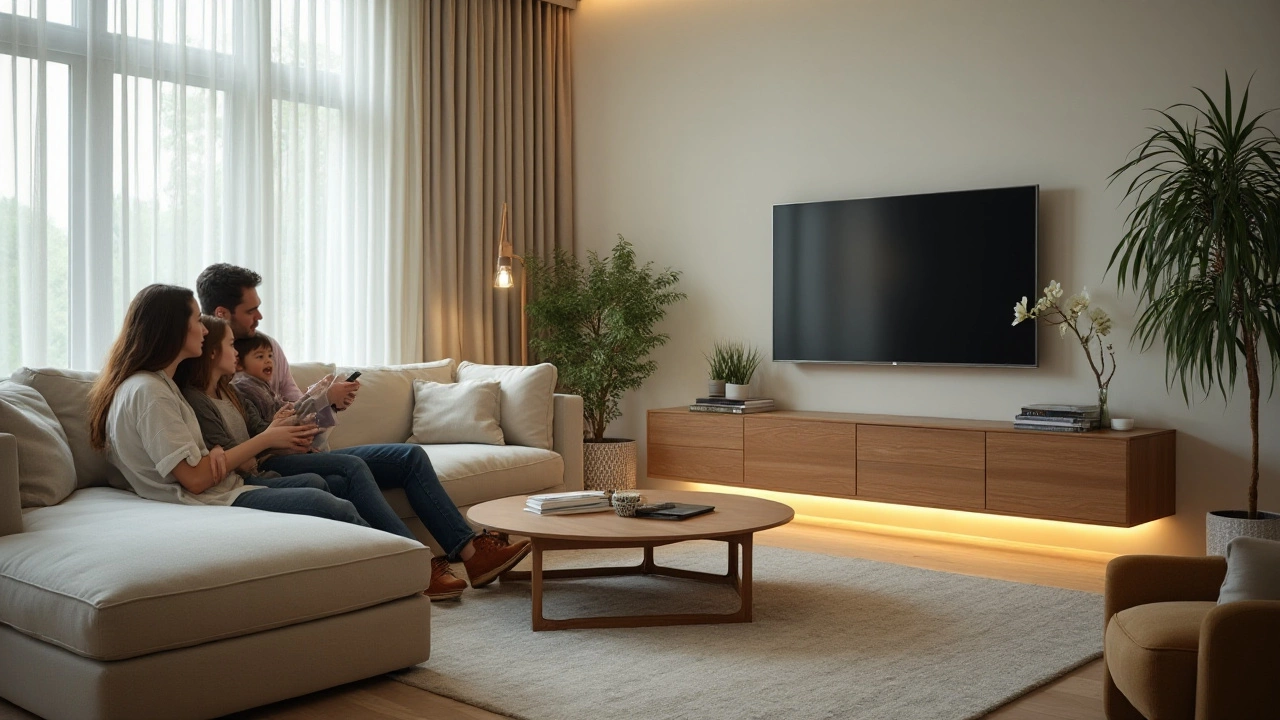
Mounting a TV stand on the wall is a game-changer for any home entertainment setup. Not only does it save floor space, but it also adds a modern touch. However, before you begin, it's crucial to ensure that your chosen TV stand is compatible with wall mounting. This isn't just about matching sizes; it's also about understanding the weight limits and structural integrity of both the TV stand and your wall.
Despite what some may think, not every TV stand is designed for wall installation. To avoid mishaps, consider the tools you'll need, which might include a drill, level, and stud finder. Also, knowing the step-by-step process can be the difference between a successful setup and an unsightly mistake.
During the installation, safety should be a top priority. Ensuring you hit the right spots on your wall can prevent unfortunate accidents. Additionally, pay attention to aesthetics; after all, you want your TV area to be as pleasing to the eye as it is practical. Whether you do it yourself or call in a professional, being informed can help everything go smoothly.
- Understanding TV Stand Compatibility
- Essential Tools and Materials
- Step-by-Step Mounting Process
- Safety Tips and Aesthetic Considerations
Understanding TV Stand Compatibility
Deciding to mount your TV stand on the wall involves more than a simple decision of style—it requires a thorough check of compatibility. Before getting started, consider that not all TV stands are engineered to be wall-mounted. This might seem like an obvious fact, but the first step is confirming whether your stand has wall-mount capabilities. Many stands in today's market are designed to be versatile in their usage, yet models without specific design features might fail under strain or damage your wall integrity. What you're looking for in these models is the VESA (Video Electronics Standards Association) pattern, which typically indicates how a television might be securely fastened to a stand or wall mount.
The VESA pattern involves a set of holes at the back of your television, as well as the corresponding holes in the TV stand. It's important because it determines whether the stand can be safely supported by a wall attachment. You'll need to measure the distance between these holes using millimeters, to make sure they match those on your wall mount bracket. Another aspect to verify is the weight capacity of your TV stand. Just because a stand fits your size doesn't imply it can handle the weight once mounted. Overloading the mount may not only ruin the TV set but could destroy the wall structure, leading to costly repairs.
Moreover, wall material plays a crucial role here. Drywalls, for instance, might not provide the best support for heavier units or stands not intended for wall mounts. Look out for dense, durable materials that can handle the bracket and TV stand setup. Consider installations into studs for an added layer of safety. Expert installer from a well-known installation service once wisely said,
"Ensuring the wall can support the TV stand is as important as the stand itself. It’s not just about matching holes; it’s about matching expectations with realistic safety standards."These words serve as a prudent reminder of the multitude of factors involved.
Finally, one size does not fit all, and there's no shame in reaching out for advice from a professional to verify your setup plans. In the world of home enhancement, it’s always better to be informed and perhaps overprepared than risk damage or personal injury. Planning a successful installation hinges not only on your readiness but also on how comprehensive your research is into your chosen stand’s specifications. Whether it be finding a stand with multiple adjustable features, or ensuring correct screen placement ergonomics, paying attention to these elements can save hours of stress and unexpected costs.

Essential Tools and Materials
Embarking on the adventure of wall mounting a TV stand is like preparing for a creative dance with tools and materials. It's not just about grabbing a random toolbox and going to town on your wall; it's more of a symphony of precision and readiness. While the task may seem daunting, having the right tools by your side ensures that the process is not only smooth but also safe. Oftentimes, homeowners underestimate this initial step, which can lead to dire consequences during installation.
First off, let's talk about your trusty screwdriver set. While this might sound basic, a variety of screwdrivers can prove invaluable as different TV stands may require various screw heads. Don't forget a sturdy drill, as this is your main assistant in making clean, precise holes. The drill bits should be compatible with the screws you will use, so ensure a perfect match to avoid any weak spots. Imagine this tool as the artist's brush, prepping the canvas, which in this case is your wall. A spirit level ensures that your installation is not lopsided, as nothing ruins the aesthetic of a mounted TV quite like a crooked setup.
Next on the list is your stud finder. Many walls hide secrets beneath their surface; these secrets are the studs – typically wooden or metal beams that provide crucial support. A stud finder ensures you hit that sweet spot, reinforcing your mount's security. Once you locate these, it ensures a more secure installation. A brisk warning for the rookies; never rely on just the wall's surface. Electrical wires lurking beneath can be bad news for you and your tools. Safety glasses might seem optional, but they're essential; one speck of flying debris can spell disaster for your eyes.
“Quality tools can ensure safety and efficiency in home projects, ultimately providing peace of mind,” says an expert in DIY interior installations.
One might overlook something as basic as a pencil and a measuring tape, but remember these are your key allies. They guide you to make accurate marks where the wall mount holes need drilling. An ideal mantra here is 'measure twice, drill once.' With your measuring tape in hand, plot out the dimensions and heights suitable for your perfect viewing pleasure. There's no one-size-fits-all because the height at which you wall mount your TV stand can impact how you enjoy evening movie sessions or game marathons.
Lastly, let’s get a bit technical: have some toggle bolts and anchors handy. Depending on your wall's composition, these elements help in spreading the load over a broader area, which is essential if you're mounting into less supportive materials like drywall. Your choice may vary based on your wall type, but they remain essential elements in spreading the strength needed for stable TV stand installations. Remember, when these bolts and other fixtures are properly used, they become the unsung heroes supporting every thrilling cinematic adventure unfolding on your screen.

Step-by-Step Mounting Process
Embarking on the journey to successfully wall mount a TV stand can be both an exciting and daunting task. It's not only about creating an appealing setup but also ensuring that it is safe and durable. Begin by selecting the right spot on your wall, preferably a location that gives everyone in the room a clear view and doesn't subject your eyes to excessive glare from windows or lights. Make sure you identify the studs within your wall using a stud finder, as these provide the necessary support when mounting heavy items such as TV stands.
Once you've marked the place, gather your tools, which typically include a power drill, level, screwdriver, measuring tape, and anchors suitable for your wall type. Here's an interesting fact: a typical 55-inch TV weighs anywhere between 25 to 50 pounds, so your mounting hardware must be able to support at least twice the weight of your TV and stand for safety. Remember, precision is crucial here. Want a pro tip? Always double-check your measurements before making any holes. As the saying goes, "Measure twice, drill once."
After prepping, it's time to proceed with installation. Start by attaching the mounting bracket to the back of your TV stand. Be sure that it's securely fastened, as this piece will bear the weight of your device. With help, hold the stand against the wall, aligning it with your previously marked spots. Slowly, drill the screws into the drilled pilot holes, ensuring that the mount remains level throughout the process. If you are working alone, consider using temporary supports or brackets to hold the weight while you work. Here's a quick piece of wisdom from the experts: "When mounting, it's vital to trust your measurements more than your eyes," as shared by a professional installer who has mastered the art of TV wall mounting.
Checking for stability after installation is paramount. You want to wiggle the TV stand slightly after it's mounted to make sure it's secure. It shouldn't budge; if it does, you may need to tighten the screws further or replace some components. Another tip during this final stage is to manage your cables neatly to avoid clutter and maintain a clean look. Use cable ties or channels to route them at the back of the stand and down to your entertainment center. This can greatly enhance the aesthetic appeal of your setup, making it both functional and stylish. Did you know that wall-mounting your TV can actually save you roughly 6 to 10 square feet of space in your living area? That's quite a bit, especially in snug quarters!

Safety Tips and Aesthetic Considerations
When embarking on the journey to wall mount your TV stand, safety should be at the forefront of your planning. One of the primary concerns is ensuring that the mount is securely fixed into solid wall studs or appropriate wall anchors. It’s crucial to use a stud finder to locate these studs if you are dealing with drywall, as they provide the sturdy support you need to prevent the TV from falling. Neglecting this step can lead to dire consequences, both in terms of personal safety and potential property damage. In fact, according to a study by the Consumer Product Safety Commission, televisions are among the top pieces of furniture involved in tip-over injuries, especially involving children. As a result, it's essential to double-check the load specifications of your mount, ensuring that it matches or exceeds the weight of your TV and the stand you're attaching.
Apart from safety, aesthetic considerations are significant in creating a visually pleasing entertainment area. A common mistake is positioning the television too high or too low, which could lead to uncomfortable viewing angles. Ideally, the center of your screen should be at or near eye level when you're seated. This not only improves comfort but enhances your viewing experience. Another element worth considering is cable management. Haphazardly hanging wires can detract from the overall aesthetic of the room and could be a safety hazard. Opt for cable raceways or in-wall wiring solutions to keep your setup tidy. "A well-managed cable structure not only enhances the aesthetics but also simplifies future troubleshooting," notes Home Entertainment Journal in their 2023 guide. Additionally, ensure adequate ventilation around the TV and the stand to prevent overheating, which is crucial for the longevity of your electronics.
Adding to the ambiance of your room can also be achieved by integrating your TV wall mounting setup with your existing decor. Consider the color and material of the mount and cables; for instance, a sleek black or metallic finish may complement modern living rooms, while wooden hues might be preferable for rustic settings. Lighting can also play a critical role, as subtle LED backlighting can reduce strain on the eyes during extended viewing sessions in dark rooms. In terms of furniture coordination, integrating shelves or cabinets with your wall mount can offer additional storage and an opportunity to display decorative items, enhancing the overall appeal. By thoughtfully considering these aspects, you not only create a safe viewing environment but also craft a sophisticated entertainment area that reflects your personal style.



